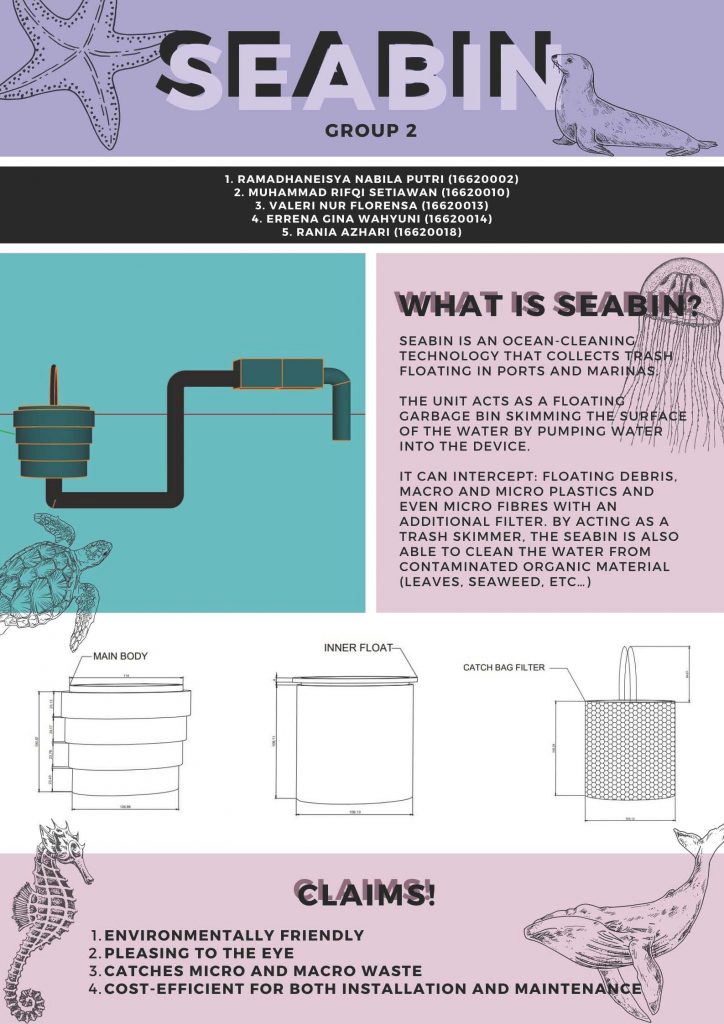K 74
Dosen :
- Dr. Benno Rahardyan, ST., MT.
- Dr. Ahmad Soleh Setiyawan
GROUP 1
? River Shuttle ?
?As of 2015, 79% of plastic waste ends up in landfills or the environment. These plastic causes pollution, including ocean pollution, which can harm the marine life and the ecosystem ???
?Preventing plastic waste from entering the ocean by collecting already existing waste in rivers can reduce about 31% ocean plastics by 2025.
?The river shuttle is a design that incorporates the inner workings of conveyor belts and sustainable power sources. It captures plastic waste using its trappers, and lead them onto the conveyor belt. Three garbage bins will be available to store wastes that are collected.
?All of this is complimented with built-in sensors that are capable of contacting the nearest operators whenever the bins are full. Last but not least, the design is solely powered by solar panels.

GROUP 2
?[SEABIN]?
Many efforts have been done to prevent plastic pollution such as using reusable bags, reducing the use of plastic straws, recycling and many more. However there is still little effort to clean up what is already in the ocean.
It is esmitated that 14 million metric tons of microplastics are already on the ocean floor in 2020. Therefore, we thought that it is important to reduce macro and microplastics that are already dumped in the ocean by constructing a system that can effectively solve this problem, which is the seabin.

GROUP 3
? [??????????? ????????????? ???????? ?? ????? ????? ??????] ?
ℹ ????????????? have been recognized to be one of the biggest threats to the environment across the world, including oceans. It is already difficult nowadays to find pure non-intoxicated water, and the presence of microplastic makes the situation worse. ♒ ???????? ?????????? has been known for its uses in wastewater treatment and is a possible solution for the treatment of drinking water as well.
? From the alternative materials we have evaluated, the ??????????? ????????????? is able to offer characteristics that allows it to perform as a high-end membrane while also being environmentally friendly and cheaper than other conventional materials.
✴ Incorporating it into a ????? ????? ????? ?????? enables it to effectively filter all the water entering the house and separate the microplastics from the water that will later be used for daily activities.

GROUP 4
? Roman aqueducts, a marvel of ancient infrastructure which spans from Europe to the Northern Africa, utilized solely for channeling water from a freshwater source. A simple, yet also ingenious infrastructure design. However the modernized version of our aqueduct allows the possibility of more multifunctional purposes such as general vehicular transportation, and pedestrian walkways. In which it amplifies the ancient design by applying innovative ideas to develop our version of the infrastructure with distinct variations and components that advances sustainable and feasible scheme of irrigation development.
? Significance & Applications
To briefly encapsulate the exemplified situaion in regards to the issue; Village A is a desolated village located near a large lake that has limited continuous expanse, while Village B is an agricultural area without any sufficient water resources that’s only reliant towards rainy seasons for water sources. Therefore such complications requires the implementation of a solution towards the distribution of water resources, as well as agricultural produce.
? How does it work?
Our aqueduct consists of two essential components, the water bridge/conduit, and the main bridge. The water conduit is, of course, utilized for collecting the water resources. While the purpose of the main bridge is to provide the ability for general transport through vehicles, and passages for local pedestrians.
The brief stages of the water accumulation process are simply elucidated. Where the water is firstly collected from its main source, which will then proceed into the intake that conveys the water towards the conduit. Then it will finally be directed towards the water basin utilized as the system for the distribution of water in that area.

![Fakultas Teknik Sipil dan Lingkungan - [:id]itb[:en]Fakultas Teknik Sipil dan Lingkungan[:]](https://ftsl.itb.ac.id/wp-content/uploads/sites/8/2021/05/logo-ftsl-1.png)